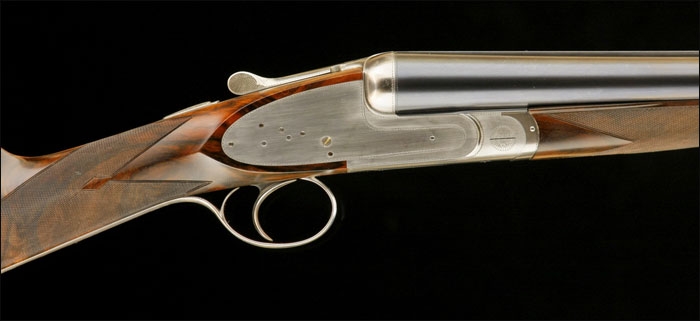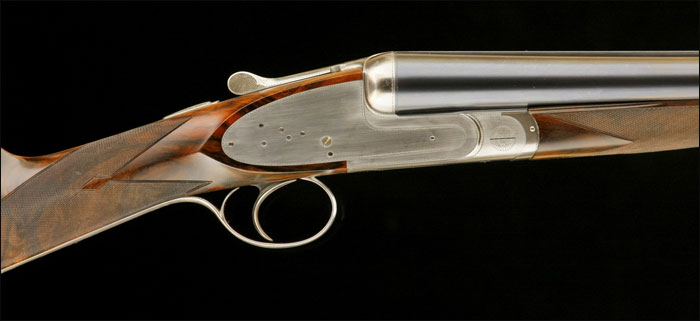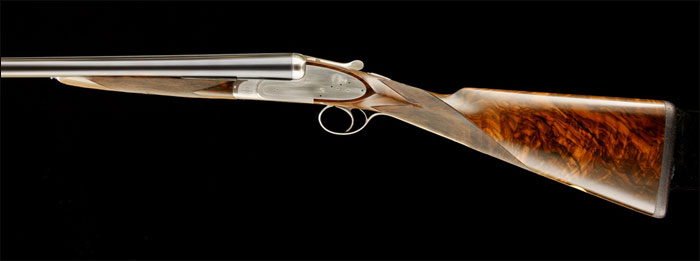A Riff on Piotti Cool

Until the Piotti Monaco, I never thought of bespoke shotguns as “cool.”
We often praise custom-made over/unders more in the vernacular of classical beauty than hip transcendence.
When talking about shotguns today, cool as an adjective usually flies around in conversations about high-tech semi-autos like the Benelli Super Vinci, the Browning Maxus Stalker and the Beretta A400 Xtreme Unico KO, or the awesome 10-gauge Remington SP-10.
But in discussions about best guns such as Purdey, Holland & Holland, Bosis, Boss, Famars and Piotti, “cool” might be a comeback when asked about a slightly chilled martini set down on the bar. Cool simply doesn’t do justice to Bulino engraved sideplates.
In post-war America, as the Beat’s hedonism and existential angst howled at mid-America, cool proved that a balanced sense of minimalism – a poet and bongo player – could rise above the ruckus of insatiable mass consumerism and convey a quiet, irrefutable truth about eternal beauty. Let’s think of Miles Davis’ “Birth of the Cool.”
I came to appreciate “cool” when describing a fine shotgun: the Monaco from F. Illi Piotti of Italy.
A 12-gauge, side-by-side, this bespoke Piotti featured a coin-finished receiver unadorned by engraving save for a subtle scroll border applied by the illustrious Creative Arts of Brescia, Val Trompia, Italy. At first glance, you could almost think the production had stopped “in the white.” Yet the gun is not a blank canvas awaiting the engraver’s hand. The Monaco’s austere demeanor has deliberately given rise to the sensibility of cool.
 The beautiful and austere Piotti Monaco.
The beautiful and austere Piotti Monaco. As a paradigm of cool, the Monaco certainly taught me a lesson about Piotti shotguns – how their presence can transcend the seemingly mundane. After all, a plain receiver is not entirely new to the universe of premium shotguns. The Perazzi MX line, Blaser’s F3, the Winchester Model 21 Field Grade and other high-quality firearms have established reputations for exemplary performance and collectability with their plain receivers. Personally, I think the stark receiver of a Blaser F3 is cool, but then there’s the sublimely cool Piotti Monaco.
When it came to the Monaco, the reaction to it by strangers, especially in light of the unembellished receiver, seemed to emphasize an indescribable loveliness about the Piotti that I could only think of as cool.
I had been at an invitation-only clays shoot for members of an exclusive club. Amid the parking lot of classy Euro-sedans I arrived in my Toyota Tundra pick-up truck – not your customary tip-off that an Italian bespoke shotgun lay cased in the locked bed.
I dropped the tailgate and uncased the gun, preparing for a day of sporting clays, when a well-appointed gentleman approached to ask about it. He was admiring it, asked questions and then finally I just handed it to him. He opened it, closed it, shouldered the gun and praised it before walking away. I had a similar experience walking from my truck to the clubhouse. And during the course of the day, another two or three people approached me when I was carrying the gun, or simply walked up to it on a gun rack.
Clearly, the Monaco was special. But why? Do Piottis radiate an ineffable star quality?
For many, F. lli Piotti remains a mystery despite having been in business for more than four decades.
In the beginning, the brothers Araldo and Faustino Piotti occupied a brick and stucco workshop in Gardone Val Trompia, which is situated in the Brescia Region – the heart and soul of Italy’s gun trade. With generations of artisan barrel makers, actioneers, engravers and stock makers in the interdependent community, Araldo and Faustino could attract the talent demanded for their fledging operation.
The Piotti brothers supported their early efforts by repairing shotguns and rifles. During lulls, they built boxlocks employing the popular Anson & Deeley action, as well as handsome hammer guns. They subsequently saw an opportunity to grow the business by making side by sides based on the Holland & Holland sidelock. Still, the business never wavered from its philosophy of relying on a small cadre of no more than 20 craftsmen to hand-build extraordinary firearms.
 The underside of the Piotti Monaco receiver is the picture of elegance.
The underside of the Piotti Monaco receiver is the picture of elegance.Their devotion to exemplary workmanship started paying dividends in the late 1960s and early 1970s, when Piotti trap guns garnered top honors in European competitions. As Piottis made their appearances in the winner’s circle, the company’s reputation spread across the Continent.
Despite their growing renown, Araldo and Faustino held fast to making guns by artfully wielded hammers, chisels and files – creating the actions for their firearms from a single block of steel. The 1970s saw a modest use of lathes, drill presses and stamping equipment in the Piotti workshop. Still, with an annual run of approximately100 guns, the bulk of production rested on the shoulders of individual craftsmen plying their trades at the bench where 300 to 400 hours would be dedicated to a single Piotti.
During this period, the first of the Monacos bearing the muted border edging made their appearance. In a way, the gun expressed the Piotti restraint that coincided with suspension of over/under production during the first half of the 1970s in order to focus more on high-quality hunting and trap guns.
In his landmark coffee-table book F. lli Piotti – Italian Fine Gun Maker, Marco Nobili wrote, “While society sought stability after the upheaval of the Sixties, the Gardone skill of creating a renowned image that was appreciated around the world helped many artisans set ambitious objectives that up to that time were unattainable.”
Mr. Nobili credited the Monaco series as marking “the beginning of the use of actions and mechanical parts made from solid pieces of construction and special steel.”
 The Piotti Monaco is seen as a modern classic – the ultimate in cool for bespoke shotguns.
The Piotti Monaco is seen as a modern classic – the ultimate in cool for bespoke shotguns. He elaborated: “With the introduction of the Monaco side-by-side in 1975 in various degrees of finishing, the Piotti brothers finally offered their top of the line gun that for many years, up to today, would be the Gardone’s company best business card.”
Also during the 1970s requests dramatically increased for more elaborate, classical, English-style engraving. Naturally, Araldo and Faustino satisfied the orders with pleasure. Their preference, however, leaned toward the cool aesthetics reflected in the Monaco. There were two reasons: first, the superior economics and shortened production cycles associated with the chaste engraving, and second was their pride of workmanship laid bare as a testament to Piotti’s quality.
Come the 1980s, Mr. Nobili observed that the Monaco side-by-side paved the way for a collector’s market in Piottis. The Monaco was perhaps the first Piotti to benefit from the growth of international markets – benefitting from a renaissance of sorts for American and European sportsmen accustomed to elaborate best guns from England and Belgium. In turn, the decade saw an influx of orders for bespoke shotguns and rifles, although the Piotti workforce remained at the perennial 20 and annual output was capped at about 100.
By the 1990s, the Piotti family decided it was time for the second generation to assume control. The four sons and cousins who had been working with their elders stepped up to run Piotti, building individual shotguns and sets of all bores with the subgauges designed on proportionate frames and actions.
 Emanuele Piotti (left) with master engraver Stefano Pedretti at the 2012 Safari Club International convention.
Emanuele Piotti (left) with master engraver Stefano Pedretti at the 2012 Safari Club International convention.Emanuele is Piotti’s defacto manager and international ambassador. He frequents conventions and sales meetings, while also sourcing the company’s extraordinary walnut from Turkey. Fabio is the lock maker who is also responsible for operations. Sergio works in production and finishing. And Rudi ensures the guns are properly assembled.
In America, Piotti’s success is attributed to its sole importer, William Larkin Moore & Sons in Scottsdale, Arizona. As fortune would have it, both Piotti and William Larkin Moore are now managed by the sons of the founders.
William Larkin Moore founder Bill Moore led the vanguard for European shotguns in America. Starting in 1968, he embarked on a quest to find nice English doubles that would be less expensive than the prestigious London gun. His friends took notice of the growing collection, leading Mr. Moore to launch his company in 1978.
As Bill Moore continued his search for notable European gun makers, he met Faustino at a gun show. Piotti has been exhibiting in a corner of a booth of anther gun manufacturer owned by an acquaintance of Mr. Moore.
He opened the first William Larkin Moore showroom in Westlake Village north of Los Angeles. In 1994, as the climate for gun regulation in California grew more hostile, a second location was opened in Arizona. Finally, the operations were consolidated in 1998.
In the course of those first 20 years, the lives of the Piotti and Moore families became intertwined – contributing to their mutual success. It was Bill Moore who immediately recognized the brilliance of Piottis and became the exclusive U.S. importer on a handshake deal with Faustino that still stands today. Bill Moore passed away in 2011 and now his son Dan manages the business with his brother, David.
 Dan Moore in the William Larkin Moore booth at the 2012 Safari Club International convention.
Dan Moore in the William Larkin Moore booth at the 2012 Safari Club International convention.Dan Moore explained the families enjoy “a close historic relationship” that encompasses the mutual love for high-performance cars by Dan and Emanuele. Dan attributes the families’ friendship behind the long-standing handshake agreement. He noted that both companies have also enjoyed uninterrupted family ownership in a segment where premium guns gun makers have been absorbed and flipped by multinational conglomerates.
Meanwhile, Piotti continues to reinvest in the plant. CNC computer controlled machinery has reduced headcount from 20 to about 14. The CNC equipment is used primarily for material removal, to the extent that the hand finishing can be performed more efficiently on the 100-percent, Italian-made masterpieces.
As it turned out, the Monaco loaned to me by William Larkin Moore had been made in the 1990s – the decade that the sons were stepping up to oversee Piotti. The gun had been ordered by a businessman to hunt pheasants in the UK, according to Mr. Moore – or as he explained: “to shoot incoming big birds.”
Ultimately, experience would tell me that it was a great pigeon gun.
The single-trigger Monaco arrived with 30-inch barrels choked improved modified and light modified. The straight grip and splinter forearm featured wonderful marbling. It included the optional $12,000 assisted opening system, hand-detachable locks and leather covered pad. With a length of pull of 14-5/8 inches, the gun surprising felt too short. Priced at $23,500 I guess it would be considered a relative bargain.
William Larkin Moore advertises it as a sporting or pigeon gun. With that in mind, I tried it on sporting clays and found the swing lethargic for a 7-pound, 9-ounce side by side. Ditto on skeet. Then I took it to the trap field: the gun lit up.
At the 16-yard line, I was pulverizing targets. The crisp trigger, flat point of impact and neutral balance felt near-perfect. Touch the target, pull the trigger, that’s it. The ejectors tossed the shells rather than spit them out. I racked up scores of 22 and 23 in 20-mile-per-hour winds. In fact, one of my regular trap-shooting buddies on the line told me I was “shooting the [expletive] out of the targets.” That’s when I realized Piotti’s Monaco would reign death on pigeons – absolutely.
After that second round of trap, my friend and I walked back to the gun rack together talking about the Monaco. I closed the gun to set it down. The Monaco emitted a tone rather than a thud. And the tone was cool.
Irwin Greenstein is the Publisher of Shotgun Life. You can reach him at contact@shotgunlife.com.
Useful resources
The Piotti web site
The William Larkin Moore web site
Read the Shotgun Life story William Larkin Moore: Gun Room or Museum? (Perhaps a Bit of Both)

Irwin Greenstein is Publisher of Shotgun Life. Please send your comments to letters@shotgunlife.com.


Comments